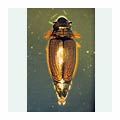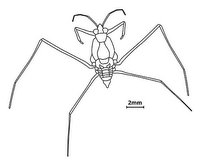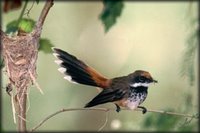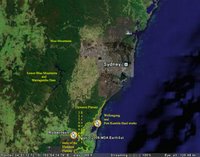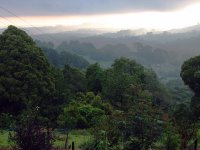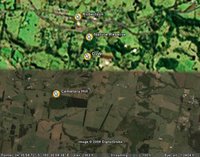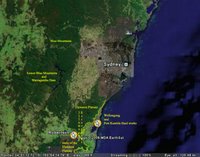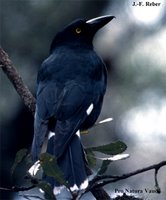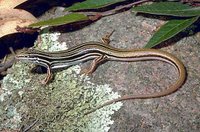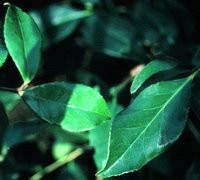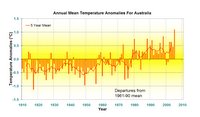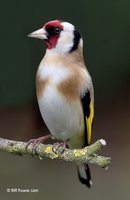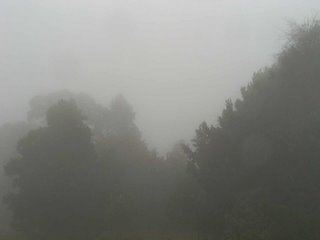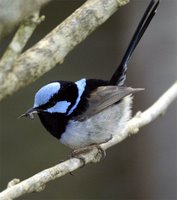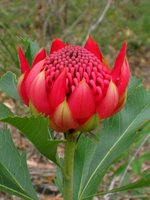
My favourite bit of bushland to wander through is below East Kangaloon, along Kirkland Road, heading towards Tourist Road. Turn off Kangaloon Road at the East Kangaloon village proper. As you drive down Kirkland Road, you will drive past potato fields and dairy farms. There are a few old huge gum trees still standing in the paddocks, which are truly magnificent, although now very old. At the Moresby Hill Road intersection, you drive into the forest.
You will notice that the colours of the area are different from Robertson's greens. Although you are in wet forest, the countryside you are entering is basically typical Sydney Sandstone bushland. In spring, you will see Waratahs beside the road. That is almost a defining plant for Sydney bushland.
As you move down Kirkland Road, you come to progressively drier country, although it still is the same type of tree cover - it is just a little bit more "open". Part of this forest was burnt about 2 years ago, so that makes it appear more open too, although the shrubbery is regenerating well. The subtle difference I was mentioning, between "wet forest" and "slightly drier forest" is caused by a slight change in soil structure, as you move further away from the red basalt soils of the ridges of Kangaloon. You have moved into true sandstone-based soil. So, it is soil, not rainfall, that determines the type of vegetation you are looking at.
 When you get to the end of Kirkland Rd, there is a T-junction with Tourist Road. You can turn right and circle back to Robertson, via the really wet patch of Eucalypt forest (complete with Tree Ferns) as you head back towards Mount Murray, and the Illawarra Highway, just above the top of Macquarie Pass.
When you get to the end of Kirkland Rd, there is a T-junction with Tourist Road. You can turn right and circle back to Robertson, via the really wet patch of Eucalypt forest (complete with Tree Ferns) as you head back towards Mount Murray, and the Illawarra Highway, just above the top of Macquarie Pass.
My personal preference is to turn left and drive (slowly) along through the forested patches, and then the cleared patches of farmland below Kangaloon, heading toward Glenquarry. The Sydney Catchment Authority has locked up the forest on your right, to preserve the integrity of the Catchment area. However, they conveniently slash a strip alongside the road, for about 5 Kms, presumably as a fire break. I don't mind. This is where the Ground Orchids and other tiny perennial native plants thrive, as the slashing cuts back the shrubbery, allowing the little plants a chance to get the light.
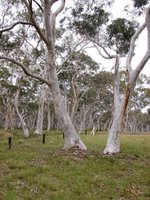 I frequently stop and walk along this slashed verge, admiring the passing parade of different flowering plants, as the seasons change.
I frequently stop and walk along this slashed verge, admiring the passing parade of different flowering plants, as the seasons change.
As you drive along, you will pass from dry grassed areas, under Scribbly Gums (some people refer to them as Ghost Gums, for their white trunks), through into tall wet forest, with very dense cover of other taller, Eucalypts.
The environmental changes are, again, due to the water-holding capacity of the soil, and its fertility. So the shallower, sandier soils have lower trees, and less of them. The heavier, richer soils have taller trees, and ferns, or Lomandras, with long strappy leaves.

Once again, different soil types give different plant communities. Give yourself a break, and stop and have a look, some time. Tiny plants are full of interest. Obviously, springtime will show you the most flowers, but there is usually always something in flower. At the moment, the
Crinkle-leaved Lomatia (Lomatia silaifolia) is showing its creamy white trusses of flowers, which look like Grevillea flowers. And
Persoonias are still flowering, as I wrote last week.
There is one wonderful patch of red-brown Kangaroo Grass, (Themeda australis) which looks totally wonderful at present. Who says grasses are boring?
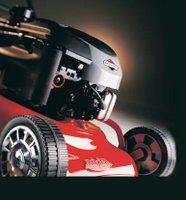 There has been a fever spreading through Robertson this last week - Lawn mowing fever.
There has been a fever spreading through Robertson this last week - Lawn mowing fever.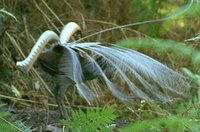 Out at "Lower Ranelagh", the resident (wild) Lyrebird was in fine voice this afternoon. A lovely thing to hear, within suburban Robertson. Blessed are those who live within range of the sound of his voice - even if he does dig up George's bulbs and other plants.
Out at "Lower Ranelagh", the resident (wild) Lyrebird was in fine voice this afternoon. A lovely thing to hear, within suburban Robertson. Blessed are those who live within range of the sound of his voice - even if he does dig up George's bulbs and other plants. 
